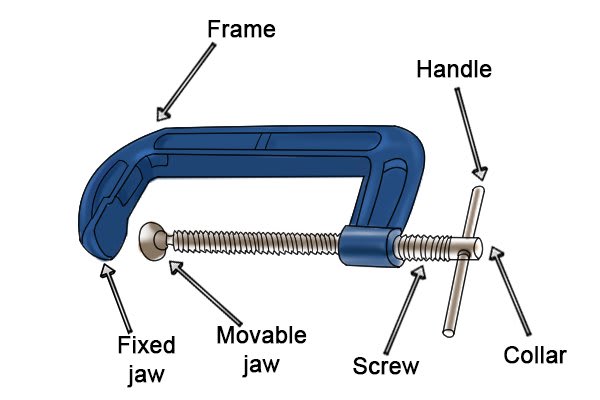Imagine this: you’re building a model airplane, meticulously attaching tiny parts with painstaking precision. You reach for a tool, a simple, humble clamp, and suddenly, your world shifts. The clamp, so often taken for granted, becomes a magician, holding everything in place, allowing you to work with confidence. It’s a moment that reveals the hidden genius within the seemingly ordinary. This is the essence of clamp science – the study of these often overlooked tools, the principles that govern their operation, and the profound impact they have on our lives.

Image:
While the idea of “clamp science” might seem unconventional, it’s a field brimming with intriguing possibilities. From the simple C-clamp used by hobbyists to the complex, high-pressure clamps employed in industrial settings, these tools play a vital role in countless applications, ranging from construction and manufacturing to scientific research and even everyday tasks like securing a picture frame.
The Anatomy of a Clamp: A Look Inside
To understand clamp science, we must first delve into the basic anatomy of a clamp. At its core, a clamp is a mechanical device designed to exert pressure and hold objects firmly in place. While there are myriad variations, the fundamental components often remain the same:
- Jaws: The primary gripping elements of a clamp. These jaws are responsible for securing the object being clamped.
- Handle: The lever that applies pressure to the jaws, typically through a screw or a lever mechanism.
- Frame: The structural support that holds the jaws and the handle together, providing stability.
Types of Clamps: A World of Variety
The world of clamps is vast and diverse, each type designed to address specific applications. Here are a few prominent examples:
- C-Clamps: The ubiquitous workhorse of DIY projects, C-clamps are characterized by their simple, C-shaped design and their ability to exert significant clamping force.
- Bar Clamps: Versatile and strong, bar clamps feature a sliding jaw that allows them to grip a wide range of object sizes.
- Spring Clamps: Ideal for light-duty applications, spring clamps rely on a spring mechanism to provide clamping force.
- Quick-Release Clamps: Offering fast and efficient clamping, quick-release clamps utilize a lever mechanism for easy release.
The Science of Clamping: Forces and Mechanisms
The science of clamping revolves around the principles of physics, particularly the interplay of forces and mechanisms. When you apply pressure to a clamp’s handle, you’re generating a force that is transmitted through the clamp’s internal structure to the jaws. This force creates clamping pressure, keeping the object securely in place. The clamping force is influenced by various factors:
- Leverage: The design of the handle determines the leverage applied, amplifying the user’s effort.
- Screw Thread: The pitch of the screw thread dictates how much force is needed to rotate the handle and apply pressure.
- Material Strength: The strength of the clamp’s frame and jaws plays a critical role in resisting deformation under heavy clamping forces.

Image:
Beyond Clamping: Applications and Innovations
Clamps have transcended their traditional role as mere holding devices to become integral components in a wide range of advanced technologies. For example, in medical devices, specialized clamps are employed for blood vessel occlusion or tissue manipulation during surgical procedures. In aerospace engineering, precision clamps are used to assemble complex structures with incredible accuracy.
Innovation in clamp science continues to push the boundaries. Advanced materials like carbon fiber are being incorporated to create lighter and more robust clamps, while intelligent sensors are being embedded in some clamps, allowing them to monitor and adjust clamping force in real-time. These developments hold immense potential for creating smarter, more efficient, and safer clamping solutions.
Tips and Expert Advice: Mastering the Art of Clamping
Having a solid understanding of clamp science and the fundamental principles behind their operation can empower you to use these tools more effectively:
- Choose the right clamp for the job: Not all clamps are created equal. Selecting the appropriate clamp based on the size, shape, and material of the object being clamped is crucial for optimal results.
- Apply clamping force gradually: Avoid overtightening the clamp, as this can damage the object or the clamp itself. Start with moderate pressure and increase it gradually as needed.
- Use clamping accessories: There are numerous accessories available, such as pads, jaws, and extensions to enhance clamping versatility. Explore these options to meet your specific clamping requirements.
- Protect surfaces: Whenever possible, use protective pads to prevent scratching or damaging delicate surfaces while clamping.
Always remember to follow safety precautions when using any clamp. Inspect the clamp for any signs of wear or damage before using it. Wear appropriate safety gear, such as gloves, to protect your hands from potential injuries.
FAQ: Unraveling the Mysteries of Clamp Science
Q: What are some typical uses for clamps?
A: Clamps are used in a wide range of applications, including woodworking, metalworking, automotive repair, construction, furniture assembly, and even scientific research.
Q: How do I choose the right size for a clamp?
A: The size of the clamp you need depends on the object you’re clamping. Always choose a clamp that can comfortably span the object’s width and provide enough clamping force without overstressing its capacity.
Q: What are some common clamping mistakes?
A: Common mistakes include overtightening, using the wrong type of clamp, not protecting surfaces, and neglecting to inspect the clamp before use.
Q: How do I maintain my clamps?
A: Keep your clamps clean and free of debris. Lubricate any moving parts regularly to ensure smooth operation. Store clamps in a dry, clean environment to prevent rust and corrosion.
Clamp Science
Conclusion: Embracing the Wonders of Clamp Science
Clamp science reveals the fascinating world of simple yet powerful tools that play a vital role in our everyday lives. By understanding the principles of clamping forces, mechanisms, and types, you can enhance your use of clamps, making your tasks more efficient and successful.
Are you fascinated by the science behind everyday objects? Do you have any clamping experiences or insights to share? Let’s discuss in the comments below!






